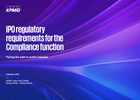Preparing for an Initial Public Offering (IPO) marks a pivotal moment in an organization’s journey. Beyond the opportunity to access new capital and enhance market visibility, it brings an increased focus on governance, transparency, and regulatory compliance. Building a strong compliance framework is vital to not only meet these obligations but to instill trust among investors and stakeholders. It lays the foundation for sustainable growth and ensures long-term success in a competitive marketplace.
The process of going public introduces specific regulatory complexities that demand meticulous planning and execution. Organizations embarking on this path must ensure their compliance infrastructure is robust, adaptable, and capable of meeting stringent regulatory standards. By addressing these requirements early, they can reduce risks and avoid delays, paving the way for a seamless transition to the public market. A forward looking approach also strengthens organizational resilience and operational efficiency, equipping businesses to thrive in an evolving regulatory environment.
While regulatory frameworks provide guidance, many companies encounter challenges in implementing them effectively. Balancing compliance with business objectives while addressing unique market conditions requires a thoughtful and tailored strategy. Closing this gap not only facilitates IPO readiness but also helps organizations achieve sustained governance and operational excellence.




